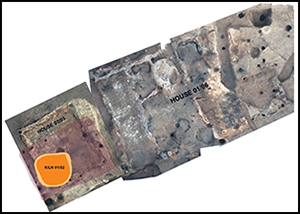Crossref Citations
This article has been cited by the following publications. This list is generated based on data provided by
Crossref.
Tasić, N.N.
Penezić, K.
Marković, S.B.
and
Catto, Norm
2016.
Vinča – Garden of Eden.
Quaternary International,
Vol. 399,
Issue. ,
p.
A1.
Czerniak, Lech
Marciniak, Arkadiusz
Bronk Ramsey, Christopher
Dunbar, Elaine
Goslar, Tomasz
Barclay, Alistair
Bayliss, Alex
and
Whittle, Alasdair
2016.
House time: Neolithic settlement development at Racot during the 5th millennium CAL B.C. in the Polish lowlands.
Journal of Field Archaeology,
Vol. 41,
Issue. 5,
p.
618.
Porčić, Marko
Blagojević, Tamara
Stefanović, Sofija
and
Caramelli, David
2016.
Demography of the Early Neolithic Population in Central Balkans: Population Dynamics Reconstruction Using Summed Radiocarbon Probability Distributions.
PLOS ONE,
Vol. 11,
Issue. 8,
p.
e0160832.
Tasić, Nenad
Marić, Miroslav
Filipović, Dragana
Penezić, Kristina
Dunbar, Elaine
Reimer, Paula
Barclay, Alistair
Bayliss, Alex
Gaydarska, Bisserka
and
Whittle, Alasdair
2016.
Interwoven Strands for Refining the Chronology of the Neolithic Tell of Vinča-Belo Brdo, Serbia.
Radiocarbon,
Vol. 58,
Issue. 4,
p.
795.
Tasić, N.N.
Penezić, K.
Marković, S.B.
and
Catto, Norm
2017.
Vinča – Garden of Eden.
Quaternary International,
Vol. 429,
Issue. ,
p.
1.
Draşovean, Florin
Schier, Wolfram
Bayliss, Alex
Gaydarska, Bisserka
and
Whittle, Alasdair
2017.
The Lives of Houses: Duration, Context, and History at Neolithic Uivar, Romania.
European Journal of Archaeology,
Vol. 20,
Issue. 4,
p.
636.
Vitezović, Selena
2017.
Antler exploitation and management in the Vinča culture: An overview of evidence from Serbia.
Quaternary International,
Vol. 450,
Issue. ,
p.
209.
Jakucs, János
Oross, Krisztián
Bánffy, Eszter
Voicsek, Vanda
Dunbar, Elaine
Reimer, Paula
Bayliss, Alex
Marshall, Peter
and
Whittle, Alasdair
2018.
Rows with the neighbours: the short lives of longhouses at the Neolithic site of Versend-Gilencsa.
Antiquity,
Vol. 92,
Issue. 361,
p.
91.
Filipović, Dragana
Gašić, Uroš
Stevanović, Nikola
Dabić Zagorac, Dragana
Fotirić Akšić, Milica
and
Natić, Maja
2018.
Carbon stable isotope composition of modern and archaeological Cornelian cherry fruit stones: a pilot study.
Isotopes in Environmental and Health Studies,
Vol. 54,
Issue. 4,
p.
337.
Higham, Thomas
Slavchev, Vladimir
Gaydarska, Bisserka
and
Chapman, John
2018.
AMS Dating of the Late Copper Age Varna Cemetery, Bulgaria.
Radiocarbon,
Vol. 60,
Issue. 2,
p.
493.
Thompson, Victor D.
and
Krus, Anthony M.
2018.
Contemplating the history and future of radiocarbon dating in the American Southeast.
Southeastern Archaeology,
Vol. 37,
Issue. 1,
p.
1.
Filipović, Dragana
Marić, Miroslav
Challinor, Dana
Bulatović, Jelena
and
Tasić, Nenad
2019.
Natural environment and resources, and the long life of the Neolithic settlement at Vinča, southeast Europe.
Archaeological and Anthropological Sciences,
Vol. 11,
Issue. 5,
p.
1939.
Birch-Chapman, Shannon
and
Jenkins, Emma
2019.
A Bayesian approach to calculating Pre-Pottery Neolithic structural contemporaneity for reconstructing population size.
Journal of Archaeological Science,
Vol. 112,
Issue. ,
p.
105033.
Porčić, Marko
2019.
Evaluating Social Complexity and Inequality in the Balkans Between 6500 and 4200 BC.
Journal of Archaeological Research,
Vol. 27,
Issue. 3,
p.
335.
Gyucha, Attila
Parkinson, William A.
and
Yerkes, Richard W.
2019.
The Evolution of a Neolithic Tell on the Great Hungarian Plain: Site Formation and Use at Szeghalom-Kovácshalom.
Journal of Field Archaeology,
Vol. 44,
Issue. 7,
p.
458.
Jakucs, János
2020.
LBK and Vinča in South-East Transdanubia: Comments on merging, interleaving and diversity.
Quaternary International,
Vol. 560-561,
Issue. ,
p.
119.
Vitezović, Selena
and
Antonović, Dragana
2020.
Functional differentiation and possible regional specialisation of the Vinča culture settlements: Viewpoint from osseous and lithic industries.
Quaternary International,
Vol. 539,
Issue. ,
p.
39.
Chapman, John
2020.
The Vinča group - (Almost) 40 years on John Chapman (independent scholar).
Quaternary International,
Vol. 560-561,
Issue. ,
p.
5.
Porčić, Marko
2020.
Observations on the origin and demography of the Vinča culture.
Quaternary International,
Vol. 560-561,
Issue. ,
p.
57.
Weninger, Bernhard
2020.
Barcode seriation and concepts of Gauge Theory. The 14C-Chronology of Starčevo, LBK, and early Vinča.
Quaternary International,
Vol. 560-561,
Issue. ,
p.
20.
